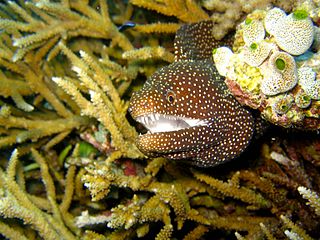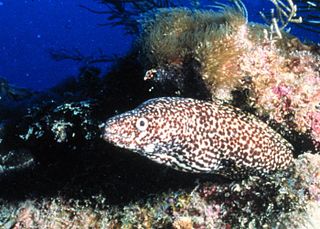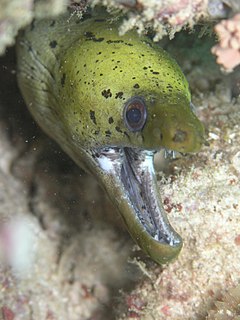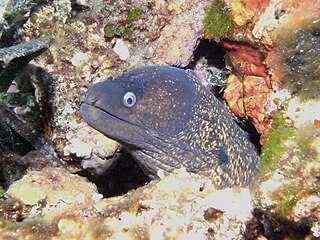| Uropterygius oligospondylus | |
|---|---|
| Scientific classification | |
| Kingdom: | Animalia |
| Phylum: | Chordata |
| Class: | Actinopterygii |
| Order: | Anguilliformes |
| Family: | Muraenidae |
| Genus: | Uropterygius |
| Species: | U. oligospondylus |
| Binomial name | |
| Uropterygius oligospondylus | |
| Uropterygius oligospondylus | |
|---|---|
| Scientific classification | |
| Kingdom: | Animalia |
| Phylum: | Chordata |
| Class: | Actinopterygii |
| Order: | Anguilliformes |
| Family: | Muraenidae |
| Genus: | Uropterygius |
| Species: | U. oligospondylus |
| Binomial name | |
| Uropterygius oligospondylus | |
It has fewer vertebrae than its congenerate animals, a gray body background with a blackish reticular pattern, and a greater body depth at gill opening 7.3.

Moray eels, or Muraenidae, are a family of eels whose members are found worldwide. There are approximately 200 species in 15 genera which are almost exclusively marine, but several species are regularly seen in brackish water, and a few are found in fresh water.

The spotted moray is a medium to large moray eel. Other common names include conger, spotted eel, red moray, speckled moray, white cong, white jawed moray, white-chinned moray and white-jawed moray eel. Spotted eels have a long snake-like body, white or pale yellow in overall color with small overlapping reddish brown to dark-brown spots. They are commonly 60 cm (24 in) in length and can grow to 2 m (6.6 ft), and weigh 2.51 kg (5.5 lb). They inhabit the Western Atlantic Ocean from North Carolina and Bermuda to Brazil, including the Gulf of Mexico and the Caribbean. They are also found around the Mid- and Eastern Atlantic islands as far south as St Helena. They are typically found anywhere from the surface to a depth of 200 m (660 ft).

The ribbon eel, also known as the leaf-nosed moray eel or bernis eel, is a species of moray eel, the only member of the genus Rhinomuraena. What is now known as R. quaesita also includes the former R. amboinensis. R. quaesita was used for blue ribbon eels and R. amboinensis for black ribbon eels, but these are now recognized as the same species. The ribbon eel is found in lagoons and reefs in the Indo-Pacific ocean, ranging from East Africa to southern Japan, Australia and French Polynesia. This species is widely distributed and is frequently seen by divers in Indonesian waters with their heads and anterior bodies protruding from crevices in sand and rubble habitats from very shallow to about 60 m. Although generally placed in the moray eel family Muraenidae, it has several distinctive features leading some to place it in its own family, Rhinomuraenidae....

Muraena is a genus of twelve species of large eels in the family Muraenidae.

Gymnothorax is a genus of fish in the family Muraenidae found in Atlantic, Indian and Pacific Ocean. With more than 120 species, it the most speciose genus of moray eels.

Uropterygius is a genus of moray eels in the family Muraenidae.

The Kidako moray is a species of marine fish in the family Muraenidae.
The Taiwanese barbel moray, Cirrimaxilla formosa, is a species of eel in the family Muraenidae, and the only member of the genus Cirrimaxilla. It was described by Hong Ming Chen and K. T. Shao in 1995. It is found only in Pingtung County, Taiwan. The holotype, a female, measures a total length of 16.6 centimetres (6.5 in).

The yellow-edged moray, also known as yellow-margin(ed) moray, leopard moray, and speckled moray, is a moray eel of the family Muraenidae, found in the Indo-Pacific Oceans at depths to 150 m (500 ft).

The European conger is a species of conger of the family Congridae. It is the largest eel in the world and native to the northeast Atlantic, including the Mediterranean Sea.

The fimbriated moray, also known as dark-spotted moray or spot-face moray, is a moray eel of the family Muraenidae.

The giant moray is a species of moray eel and a species of marine fish in the family Muraenidae. In terms of body mass, it is the largest moray eel; however, the slender giant moray is the largest in terms of body length.

The Mediterranean moray is a fish of the moray eel family. It has a long eel-like body and is found in the eastern Atlantic Ocean and Mediterranean Sea. Its bite can be dangerous to humans.

An eel is a ray-finned fish belonging to the order Anguilliformes, which consists of eight suborders, 19 families, 111 genera, and about 800 species. Eels undergo considerable development from the early larval stage to the eventual adult stage, and most are predators.
Gymnothorax niphostigmus, the snowflake-patched moray, is a moray eel found in the northwest Pacific Ocean around Taiwan. It was first named by Chen, Shao, and Chen in 1996.
The freshwater moray eel is a species of moray eel that is native to the Indo-Pacific region, including Sri Lanka, the Philippines, Indonesia, Papua New Guinea, the northern coastline of Australia, and various islands in the western Pacific. Other common names include the many-toothed moray, spotted freshwater moray, blackspotted moray, and tiger freshwater moray.

The banded moray, also known as the banded reef-eel, Rüppell's moray, Rüppell's moray eel, black barred eel, yellow-headed moray eel or yellow-headed moray, is a moray eel found in coral reefs in Red Sea, East Africa to Hawaii, Tuamotu, Marquesas Islands, north of Ryukyu Islands and south of the Great Barrier Reef. It is a pale grey to greyish-brown moray with a 16-21 dark bars on the body and fins that become indistinct with growth, top of the head yellow and a dark spot at the corner of the mouth.
Gymnothorax taiwanensis is a moray eel found in coral reefs in the northwest Pacific Ocean around Taiwan. It was first named by Chen, Loh and Shao in 2008.
The black body moray is an eel in the family Muraenidae. It was described by Loh Kar-Hoe, Shao Kwang-Tsao, and Chen Hong-Ming in 2011. It is a tropical, marine eel which is known from southeastern Taiwan, in the Pacific Ocean. Males are known to reach a maximum total length of 49.6 cm, while females are known to reach a maximum of 50.4 cm.
The Shao's moray is an eel in the family Muraenidae. It is a marine, temperate-water eel known from Taiwan, in the northwest Pacific Ocean. Males are known to reach a maximum total length of 60.8 cm.